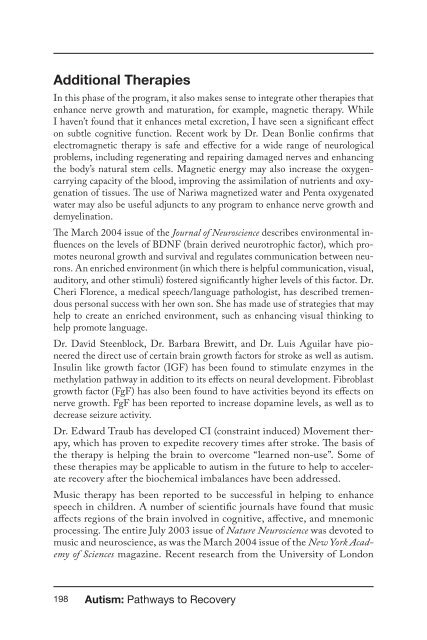3dT4E4Rnm
3dT4E4Rnm
3dT4E4Rnm
Create successful ePaper yourself
Turn your PDF publications into a flip-book with our unique Google optimized e-Paper software.
Additional Therapies<br />
In this phase of the program, it also makes sense to integrate other therapies that<br />
enhance nerve growth and maturation, for example, magnetic therapy. While<br />
I haven’t found that it enhances metal excretion, I have seen a significant effect<br />
on subtle cognitive function. Recent work by Dr. Dean Bonlie confirms that<br />
electromagnetic therapy is safe and effective for a wide range of neurological<br />
problems, including regenerating and repairing damaged nerves and enhancing<br />
the body’s natural stem cells. Magnetic energy may also increase the oxygencarrying<br />
capacity of the blood, improving the assimilation of nutrients and oxygenation<br />
of tissues. The use of Nariwa magnetized water and Penta oxygenated<br />
water may also be useful adjuncts to any program to enhance nerve growth and<br />
demyelination.<br />
The March 2004 issue of the Journal of Neuroscience describes environmental influences<br />
on the levels of BDNF (brain derived neurotrophic factor), which promotes<br />
neuronal growth and survival and regulates communication between neurons.<br />
An enriched environment (in which there is helpful communication, visual,<br />
auditory, and other stimuli) fostered significantly higher levels of this factor. Dr.<br />
Cheri Florence, a medical speech/language pathologist, has described tremendous<br />
personal success with her own son. She has made use of strategies that may<br />
help to create an enriched environment, such as enhancing visual thinking to<br />
help promote language.<br />
Dr. David Steenblock, Dr. Barbara Brewitt, and Dr. Luis Aguilar have pioneered<br />
the direct use of certain brain growth factors for stroke as well as autism.<br />
Insulin like growth factor (IGF) has been found to stimulate enzymes in the<br />
methylation pathway in addition to its effects on neural development. Fibroblast<br />
growth factor (FgF) has also been found to have activities beyond its effects on<br />
nerve growth. FgF has been reported to increase dopamine levels, as well as to<br />
decrease seizure activity.<br />
Dr. Edward Traub has developed CI (constraint induced) Movement therapy,<br />
which has proven to expedite recovery times after stroke. The basis of<br />
the therapy is helping the brain to overcome “learned non-use”. Some of<br />
these therapies may be applicable to autism in the future to help to accelerate<br />
recovery after the biochemical imbalances have been addressed.<br />
Music therapy has been reported to be successful in helping to enhance<br />
speech in children. A number of scientific journals have found that music<br />
affects regions of the brain involved in cognitive, affective, and mnemonic<br />
processing. The entire July 2003 issue of Nature Neuroscience was devoted to<br />
music and neuroscience, as was the March 2004 issue of the New York Academy<br />
of Sciences magazine. Recent research from the University of London<br />
198 Autism: Pathways to Recovery


